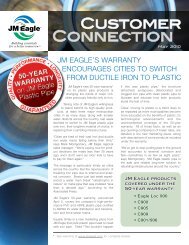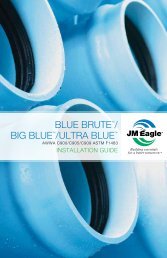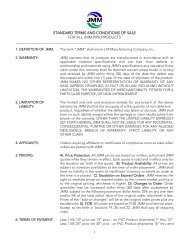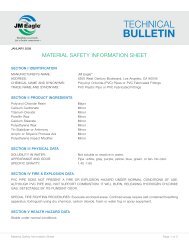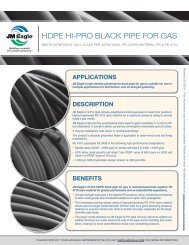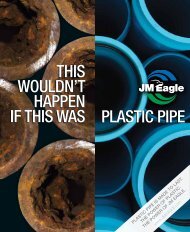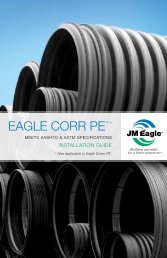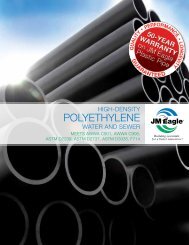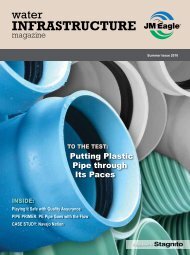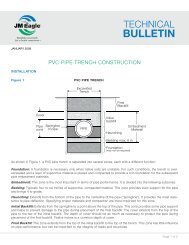Polyethylene Water/Sewer - JM Eagle
Polyethylene Water/Sewer - JM Eagle
Polyethylene Water/Sewer - JM Eagle
- No tags were found...
Create successful ePaper yourself
Turn your PDF publications into a flip-book with our unique Google optimized e-Paper software.
In cold-weather conditions, more effort will be required to uncoil the pipeand piping will spring back more forcibly if the ends are not anchored or restrained.Carefully follow equipment manufacturer’s recommendations andguidelines for cold-weather conditions.3.7 Other Handling PrecautionsDuring the transport of pipe, it should be continuously supported in a mannerso as to minimize movement between the pipe and its support. Anypractice of carrying supplies or equipment on top of plastic pipe should beavoided because of damage from sharp edges and other projections.Care should be taken to protect the pipe from excessive heat. Be particularlycareful of open flames. Do not lay an open flame or torch across pipe surfaces.3.8 TrenchingFor direct burial of <strong>JM</strong> <strong>Eagle</strong> Municipal & Industrial <strong>Water</strong> or <strong>Sewer</strong> Pipe,trench bottoms should be relatively smooth, continuous and free of rocksand other debris. When ledge rock, hardpan or boulders are encountered,the bottom of the trench should be padded with sand or other fine-grainedfill materials. The trench should be wide enough to allow (a) fusion in theditch if required, (b) snaking of the pipe along the bottom of the trench ifneeded, and (c) filling and compaction of sidewalls. Minimum trench widthscan be utilized in most instances by joining the pipe before lowering it intothe trench. Refer to ASTM D2321, “Standard Practice for Underground Installationof Thermoplastic Pipe for <strong>Sewer</strong>s and Other Gravity Flow Applications”and ASTM D2774 “Standard Practice for Underground Installation ofThermoplastic Pressure Piping” for additional information.Generally, sufficient cover must be maintained to provide reasonable protectionagainst anticipated external stress loads. Where frost penetration andsurface loads need not be considered, a minimum depth to provide 18 inchesof cover above the pipe is recommended. When surface loads are expected,a minimum of 3 feet of cover is recommended. Where frost is a factor, pipeshould be buried 6 inches below greatest recorded frost penetration.14 HDPE WATER/SEWER PIPING SYSTEM TECHNICAL & INSTALLATION GUIDE



